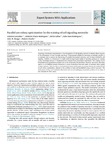Parallel ant colony optimization for the training of cell signaling networks

Use este enlace para citar
http://hdl.handle.net/2183/31806
A non ser que se indique outra cousa, a licenza do ítem descríbese como Atribución-NoComercial-SinDerivadas 3.0 España
Coleccións
- Investigación (FIC) [1728]
Metadatos
Mostrar o rexistro completo do ítemTítulo
Parallel ant colony optimization for the training of cell signaling networksAutor(es)
Data
2022Cita bibliográfica
P. González, R. Prado-Rodriguez, A. Gábor, J. Saez-Rodriguez, J. R. Banga, y R. Doallo, «Parallel ant colony optimization for the training of cell signaling networks», Expert Systems with Applications, vol. 208, 1 dic. 2022, doi: 10.1016/j.eswa.2022.118199.
Resumo
[Abstract]: Acquiring a functional comprehension of the deregulation of cell signaling networks in disease allows progress in the development of new therapies and drugs. Computational models are becoming increasingly popular as a systematic tool to analyze the functioning of complex biochemical networks, such as those involved in cell signaling. CellNOpt is a framework to build predictive logic-based models of signaling pathways by training a prior knowledge network to biochemical data obtained from perturbation experiments. This training can be formulated as an optimization problem that can be solved using metaheuristics. However, the genetic algorithm used so far in CellNOpt presents limitations in terms of execution time and quality of solutions when applied to large instances. Thus, in order to overcome those issues, in this paper we propose the use of a method based on ant colony optimization, adapted to the problem at hand and parallelized using a hybrid approach. The performance of this novel method is illustrated with several challenging benchmark problems in the study of new therapies for liver cancer.
Palabras chave
Cell signaling network
Metaheuristics
Ant Colony Optimization
High performance computing
MPI
OpenMP
Metaheuristics
Ant Colony Optimization
High performance computing
MPI
OpenMP
Versión do editor
Dereitos
Atribución-NoComercial-SinDerivadas 3.0 España
ISSN
0957-4174






